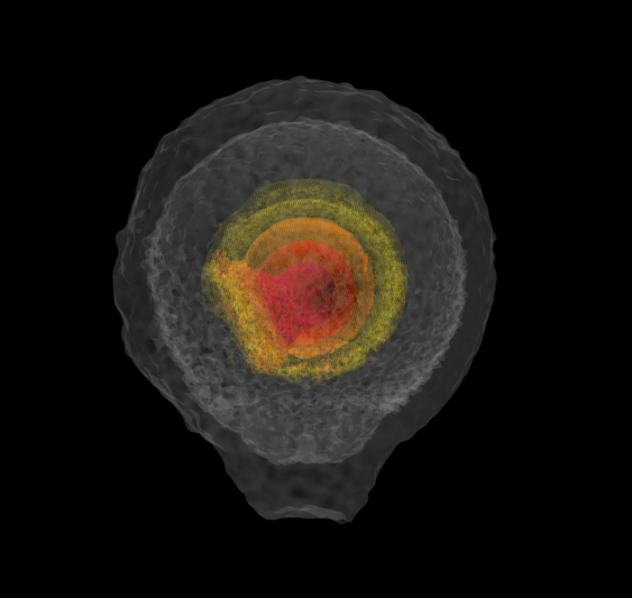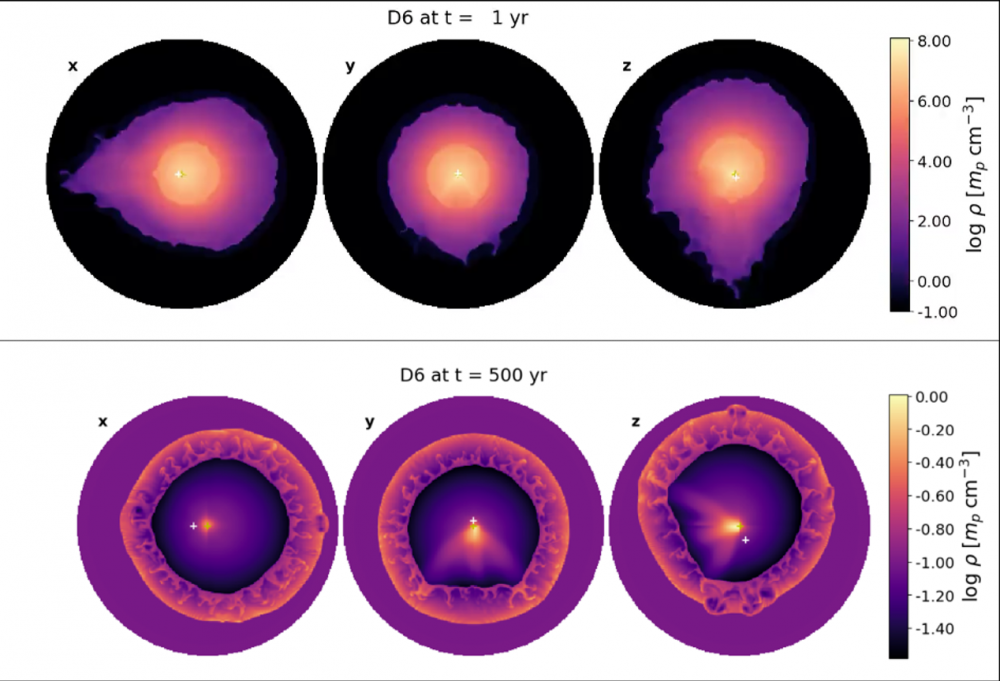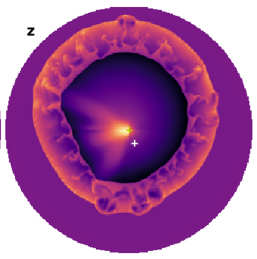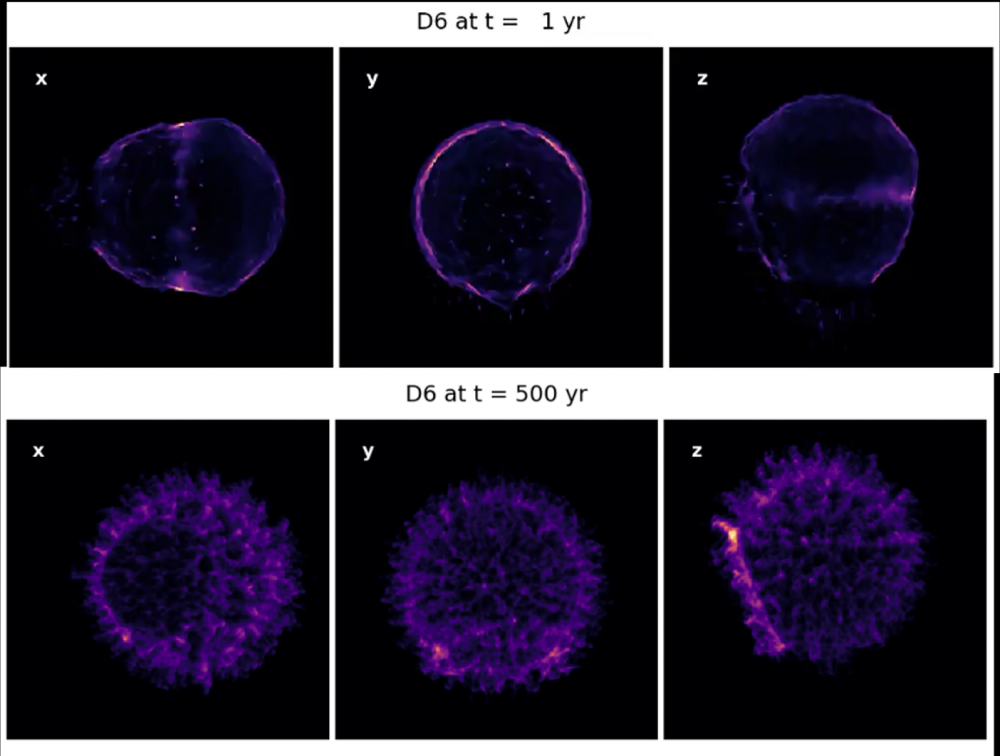While type Ia supernovae are considered as highly symmetric supernovae, the explosion in a tight binary system composed of two white dwarfs revises this paradigm. An international team (Japan, Canada, France), including a researcher from the Department of Astrophysics/AIM Laboratory of CEA Paris-Saclay, publishes a study in the Astrophysical Journal that reveals that the distinctive asymmetric structures of such a supernova leave post-mortem imprints on the morphology of the ejected matter. These morphological signatures persist and are observable in the late phase of supernova remnants. These results open the possibility to identify and characterize the explosion scenario of this type of supernova.
Standard candles
Type Ia supernovae (SNe Ia) result from the explosion of a white dwarf composed of carbon and oxygen in a binary system. Based on their relative homogeneity, they are used as "standard candles" to estimate the distances of galaxies in the Universe and show that the expansion of the Universe is accelerating. However, there is currently no established consensus on how they explode and on the nature of the companion in the binary systeme.
Deflagration or detonation ?
The explosion of an SN Ia is triggered by a mass transfer from the companion star to the white dwarf in a binary system. But it can also, more radically, result from the fusion of two white dwarfs. Two main explosion scenarios are currently considered: a deflagration followed by the detonation of the core, or a double detonation. In both cases, the destruction of the white dwarf is complete.

Morphology of a D6 supernova Ia 50 seconds after the explosion: the cone of matter (center left of the image) is generated by the presence of the companion white dwarf; the deformation of the outer layer (bottom of the image) is due to the first detonation, on the surface.
Morphologie de la supernova Ia
Nature of the binary system?
What binary system are we talking about and what is the nature of the companion star? Is it a "simgle degenerate" system composed of a white dwarf and a star in hydrogen or helium fusion phase, or a "double degenerate" system composed of two white dwarfs?
Attempts to identify surviving companions in historical type Ia supernova remnants have been unsuccessful. But in 2018, astronomers discovered, thanks to the GAIA satellite, three hypervelocity white dwarfs in our Galaxy that have been interpreted as SNe Ia survivors. Indeed, in the case of two white dwarfs in close orbit on the way to merge, an unstable mass transfer can cause the explosion of the more massive white dwarf, leaving the companion white dwarf to escape at a very fast speed from the system. This recent explosion model is called "Dynamically driven, double-degenerate, double detonation", or D6 for short.
This discovery has motivated a lot of work to examine the conditions and properties of such a « D6 » explosion of SNe Ia. This tight double-degenerate, double-detonation binary system is promising; it allows the researchers to explain a number of properties of SNe Ia that are not reproduced by a simply degenerate system.

Slices of density of a D6 SN Ia remnant at 1 yr and 500 yr after the explosion, along each axis (x, y, z), illustrating the presence of asymmetric structures, including the cone generated by the presence of the companion white dwarf. The small yellow cross represents the center of the explosion, the white cross represents the surviving white dwarf that was ejected at high speed.
Numerical code
It is in this context that the team of researchers has numerically modeled in 3D the hydrodynamic evolution of a D6 supernova, from its explosion to its mature supernova remnant phase after several thousand years.
The 3D numerical simulation code used, the RAMSES code, was developed at the Astrophysics Department/UMR AIM, as well as its adaptation to follow the evolution and physics of supernova remnants. This version was initially used to study the impact of particle acceleration on the evolution of the morphology of supernova remnants and on their multi-wavelength emission. A co-moving grid allows the team to follow the expansion of the ejected matter. The resolution of the grid is further increased by the adaptive mesh refinement of RAMSES in order to follow the structures generated by the shocks.
Morphological signatures of a D6 supernova Ia
The proximity of the companion produces distinctive asymmetric structures of D6 supernova that are found in the form of several morphological signatures in its supernova remnants, opening the possibility of identifying and characterizing of the supernova explosion scenario:
- A protrusion of the ejecta located opposite the location of the initial external detonation into the helium layer, which dissipates after several hundred years.
- A density peak in the core of the ejecta, resulting from the second detonation
- A shift of the ejecta with respect to the explosion point of the supernova generated by the initial velocity of the white dwarf in the binary system
- An important "shadow" cone generated by the presence of the companion which results in a less dense area surrounded by a denser ring rich in hydrodynamic instabilities. It is this signature which is the most marked and the most durable in the evolution of the supernova remnant.
The next step will be to produce X-ray emission maps of an Ia D6 supernova remnant for comparison with existing observations, as well as the associated high spectral resolution spectra that will be accessible with the future Athena Large X-ray Observatory.
Additional material:
- Interactive 3D images on Sketchfab : here and there
- Animation of the evolution of a D6 supernova remnant
- Animation: evolution in density from 1 to 4000 years
- Animation: morphological evolution from 1 to 4000 years
See also : Canadian press release, Japanese press release
Contacts CEA: Anne Decourchelle
Publication:
“The double detonation of a double degenerate system, from Type Ia supernova explosion to its supernova remnant ” , Gilles Ferrand, Ataru Tanikawa, Donald C. Warren, Shigehiro Nagataki, Samar Safi-Harb and Anne Decourchelle, The Astrophysical Journal, 2022, 930, 92 (DOI: 10.3847/1538-4357/ac5c58)
https://arxiv.org/abs/2202.04268
Rédaction : Anne Decourchelle
• Structure and evolution of the Universe › High energy cosmic phenomena and astroparticles
• Department of Astrophysics (DAp) // UMR AIM
• High Energy Cosmic Phenomena Research Laboratory
• Fermi





